Abstract
In this paper, the issue of direction of arrival (DOA) estimation is discussed, and a partial angular sparse representation (SR)-based method using a sparse separate nested acoustic vector sensor (SSN-AVS) array is developed. Traditional AVS array is improved by separating the pressure sensor array and velocity sensor array into two different sparse array geometries with nested relationship. This improved array geometry can achieve large degrees of freedom (DOF) after the extended vectorization of the cross-covariance matrix, and only partial SR of the angle is required by exploiting the cyclic phase ambiguity caused by the large inter-element spacing of the virtual array. Joint sparse recovery is developed to amend the grid offset and unitary transformation is utilized to transform the complex atoms into real-valued ones. After sparse recovery, the sparse vector can simultaneously provide high-resolution but ambiguous angle estimation and unambiguous reference angle estimation embedded in the AVS array, and they are combined to obtain unique and high-resolution DOA estimation. Compared to other state-of-the-art DOA estimation methods using the AVS array, the proposed algorithm can provide better DOA estimation performance while requiring lower complexity. Multiple simulation results verify the effectiveness of the approach.
1. Introduction
Sensor arrays can utilize signals from multiple paths to overcome fading effect and enhance system capacity, so they have found wide application in many fields [1,2,3,4]. As a key issue for sensor array signal processing, direction of arrival (DOA) estimation has attracted lots of attention in many systems, e.g., radar [5,6], sonar [7], and wireless communication [8,9], to name a few. Compared to the conventional scalar sensor array, which only measures signal pressure information, the acoustic vector sensor (AVS) array provides a vector output, which contains both pressure and velocity information, so it can further extend array aperture and strengthen parameter identifiability [10]. Furthermore, the AVS array itself can provide unambiguous reference DOA estimation, which enables the inter-element spacing of the array to be larger than half-wavelength to enhance spatial resolution [11]. Since its introduction, DOA estimation using AVS array has attracted growing interest [11,12]. Many effective DOA estimation methods using AVS array have been developed, such as the estimation of signal parameters via rotational invariance technique (ESPRIT)-based method [11], Capon-based method [12], self-initiating multiple signal classification (MUSIC) method [13], propagator method (PM) [14], high-order decomposition-based method [15], and successive MUSIC-based methods [16,17]. However, the array geometries they used were simply evolutions of the conventional compact scalar array, which has limited degrees of freedom (DOF).
Recently, the research into sparse array geometries has been attractive, for they can achieve high DOFs in the co-array domain. Two well-known sparse array geometries are the coprime array [18] and the nested array [19]. The coprime array has large inter-element spacing and can achieve unique DOA estimation based on the coprime-ness [20,21], but its virtual array has many holes, which may enhance the sidelobe. The nested array can achieve O(N2) contiguous virtual elements in the co-array domain with only O(N) physical elements, and it has been applied in radar [22,23] and sonar [24] systems. In [25], the nested array concept was applied to AVS array signal processing, and the DOA could be estimated via tensor modelling, but only the AVS was adopted, instead of the pressure sensor, so the array geometry does not fit the AVS well. In [26], we separated the pressure sensor array and velocity sensor array in the AVS array into two nested geometries, generating high DOFs in the co-array domain, but sparse representation (SR) covering the whole angular range is required. Additionally, both the methods in [25,26] assume the sources are correctly located in the predefined grid, which actually cannot be guaranteed, no matter how fine the grid is [27]. The grid mismatch problem may intensively degrade the DOA estimation performance [28].
In this paper, we propose a sparse separate nested (SSN) AVS array, which separates the pressure sensor array and velocity sensor array into two different geometries, which have a nested relationship, while both have large inter-element spacing. This array geometry generates a long virtual array with large inter-element spacing in the co-array domain, and then only partial angular SR is required by exploiting the cyclic phase ambiguity caused by the large inter-element spacing. Meanwhile, unitary transformation is employed to transform the complex atoms into real-valued ones, and joint SR is formulated to amend the offsets caused by the off-grid sources. After sparse recovery, the non-zero positions and elements in the sparse vector can provide high-resolution but ambiguous angle estimation and unambiguous reference angle estimation, respectively. Finally, they are combined to obtain unique and high-resolution DOA estimation. Complexity analysis and multiple simulations verify that the proposed method outperforms the successive MUSIC [17], tensor-based [25] and SR-based methods [26] in terms of computation complexity, estimation accuracy, angle resolution and robustness to nonuniform noise.
The rest of the paper is organized as follows. Section 2 introduces the data model for the proposed SSN-AVS array. Section 3 shows the major steps of the proposed DOA estimation method, as well as some summaries and analyses. The simulation results are presented in Section 4 to verify the effectiveness of the proposed method, while the conclusions are made in Section 5.
Notation: , , and denote the transpose, conjugate, conjugate-transpose, and pseudo-inverse operations, respectively. means expectation. diag(a) means a diagonal matrix, with a being the diagonal. vec(.) is the vectorization of a matrix. and denote the Kronecker product and Hadamard product, respectively. and are K × K identity matrix and reverse identity matrix, respectively. means element-wise division, and angle(.) means to extract the phase.
2. Data Model
A Traditional AVS geometry is shown in Figure 1a, where the M AVSs are uniformly arranged, with inter-element spacing being Nd (d is the unit spacing, which is generally set as half-wavelength). The AVS consists of a pressure scalar sensor and two identical but orthogonally oriented velocity vector sensors. Due to the directivity of the velocity sensors, the AVS array itself can provide unambiguous reference angle estimation [11,16], which enables the inter-element spacing to be larger than half-wavelength to enhance spatial resolution (the spacing is Nd in Figure 1a). However, as the pressure sensor array and the velocity sensor array have the same array geometry, which results in many redundant virtual elements in the difference co-array domain (we will discuss this in Section 3), the achieved DOF is limited. We propose an SSN-AVS array shown in Figure 1b, where the pressure sensors are extracted and arranged along the negative side with inter-element spacing being MNd. The pressure sensor and velocity sensors are no longer co-located but separated into two different geometries with nested relationship.
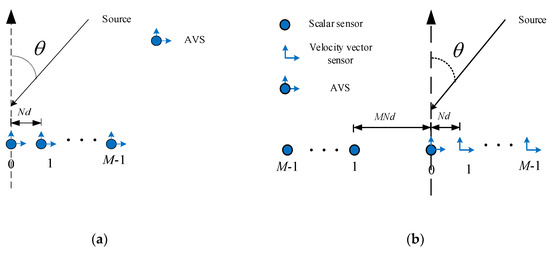
Figure 1.
(a) Traditional AVS array; (b) the proposed SSN-AVS array.
Assuming that there are K far-field uncorrelated source signals impinging on the proposed array, then the output of the pressure sensor array is formulated as
where is a vector containing all the K source signals, is the additive white Gaussian noise vector, and denotes the direction matrix, which depends on the geometry of pressure sensor array. The steering vectors are expressed as
Similarly, the outputs of the velocity vector sensor array are expressed as
where and are two diagonal matrices reflecting different components along different axes. and are additive white Gaussian noise vectors. is the direction matrix of the velocity sensor array, and the steering vectors are expressed as
According to Equation (2) and Equation (5), the steering vectors of the pressure sensor array and velocity sensor array satisfy nested relationship, which will greatly increase the DOF in the co-array domain shown in the next section. It is also noted that the proposed SSN-AVS array just separates the pressure array and velocity array, it does not add extra AVS, which can be observed from Figure 1, so the total AVS number is still M.
3. Partial Angular Sparse Representation Based DOA Estimation Method
3.1. Virtual Array in the Co-Array Domain
According to Equation (1) and Equation (3)–Equation (4), the cross-covariance matrix between and is
where is a diagonal matrix, whose diagonal elements are the signal powers [29]. The cross-covariance matrix used in Equation (6) can effectively reduce the influence of nonuniform noise.
Thereafter, to obtain the virtual array in the co-array domain, we vectorize the cross-covariance matrix as
where is a vector, and can be regarded as a new signal vector in the co-array domain. can be regarded as a new direction matrix corresponding to a M2-element virtual array, whose steering vectors are expressed as
Based on Equation (2) and Equation (5), now an M2-element virtual array with inter-element spacing Nd can be achieved. Compared to the original physical array in Figure 1, the virtual array shows much larger DOF. Additionally, the new signal vector is a real-valued one, which means that the array aperture can be furtherly extended by combining the conjugate data of the vector in Equation (7). Construct the extended vector as
where means to extract the first (M2−1) elements of , and means the first (M2 − 1) rows of . Here, we extract the first (M2 − 1) elements of to eliminate the overlapped origin element in the extended virtual array. is the extended direction matrix, whose steering vectors are expressed as
Based on Equation (9), now a (2M2 − 1)-element virtual array with steering vectors being can be obtained, and the large DOF can be expected to improve the parameter estimation performance and system capacity. If the traditional array geometry in Figure 1a is used, then the virtual steering vector in Equation (8) will have many redundant elements due to the same geometry being used by the pressure array and velocity array. Additionally, the aperture extension in Equation (9) will be unavailable, and the final achievable DOF will be (2M − 1), which is much smaller than what the proposed geometry achieved.
It is shown that the steering vector in Equation (10) satisfies conjugate symmetrical property, so unitary transformation can be employed to transform the complex vector into real-valued one [30], which can effectively reduce the computation complexity.
The unitary matrix is defined as
Then the extended steering vector can be transformed into a real-valued vector
According to Equation (9) and Equation (12), the real-valued data is obtained via
where is the real-valued direction matrix.
Based on , and the steps from Equation (6) to Equation (13), now the real-valued data is obtained. Similarly, based on and , whose cross covariance matrix is , another real-valued vector can be obtained
where . Combining and yields
where contains unambiguous DOA information, which is embedded in the AVS array (generated from and ).
Now a virtual array with output being is obtained, and the direction matrix is real-valued, and sparse representation-based DOA estimation can be developed.
3.2. Partial Angular Sparse Representation
Suppose that the angle grid of interest is , which contains the true DOAs. Then construct the dictionary , which must contain the columns of , so Equation (15) can be written as
where is a P-element vector, which only has K non-zero elements from , and the positions of the non-zero elements give the DOA estimations. However, according to Equation (10), the inter-element spacing of the (2M2 − 1)-element virtual array is Nd, which means phase ambiguities in this array. Let denotes the phase difference between adjacent elements corresponding to angle , then there are another (N − 1) angles satisfying
The phase ambiguity shown in Equation (17) will cause multiple false angle estimations. However, we can in turn exploit the ambiguity to shrink the size of the dictionary and focus on one specific cycle. It is derived from Equation (17) that the N angles satisfy
where is an integer ensuring located in the range [−1, 1]. According to Equation (18), the N solutions ( and ) are uniformly distributed within the range [−1, 1] with adjacent distance being 2/N. Figure 2 shows an example when and N = 3, and other two ambiguous solutions are and , respectively. If we divide the range [−1, 1] into N cycles with each width being 2/N, then one cycle provides only one solution. Therefore, we can choose one specific cycle as a representative to construct the dictionary, and recover other solutions based on their uniform distribution after sparse vector recovery. Without loss of generality, we choose range [−1/N, 1/N], whose corresponding angular range and dictionary are and , respectively. Then the sparse representation can be expressed as
where the elements in corresponding to the representative solutions are the same as those in , and the others are zero. For example, as Figure 2 shows, the true solution 0.5 is represented by −1/6 in .
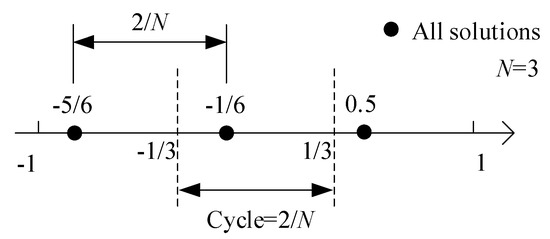
Figure 2.
The cyclic solution distribution (N = 3).
Now the sparse representation based on partial angular domain is conducted, and the phase ambiguity can be avoided. However, Equation (19) is established based on the assumption that the representative angles are right located in the pre-defined grid, but the angles are very likely to lie off the grid, no matter how fine the grid is defined. The grid mismatch will degrade the sparse recovery performance. Consequently, an improved sparse presentation framework should be developed to tackle the off-grid problem.
3.3. Joint Sparse Representation Framework
In this section, we take the off-grid angles into account, and utilize the joint sparse representation framework to enhance the robustness to grid mismatch.
Denote the new grid within the partial angular range as , which is uniformly sampled. Then the true representative angle can be represented by a nearest grid angle plus an offset (maybe zero when the true angle is right on the gird). Based on first-order Taylor expansion around the predefined grid, the true steering vector can be approximately expressed as [28,31]
Then, Equation (19) has a robust form
where denotes the derivatives on the sampling grid, is a diagonal matrix containing the offsets, and
So is also a sparse vector with K non-zero elements. Let , then and are joint sparse. Equation (21) is rewritten as
Equation (23) is a joint sparse recovery problem, and joint orthogonal matching pursuit (JOMP) [31] can be utilized to recover the sparse vectors ρ and ω. The basic steps of JOMP are shown in Table 1. It is noted that the grid can be coarse due to offset compensation afterwards [28], so the sparse recovery complexity can be reduced.

Table 1.
Basic steps for JOMP.
3.4. Ambiguity Elimination and DOA Estimation
After sparse recovery using JOMP, the estimations of and can be obtained. The positions of non-zero elements in give the grid angles , which are nearest to the representative angles. Meanwhile, the offsets are obtained via
From Equation (24), the offsets can be acquired, then the angles estimated in the representative range are
The angles obtained in Equation (25) are representative angles. Finally, we need to resolve the ambiguity problem in the angle estimation. According to Equation (18), from one specific angle , we can recover a total of N angles.
To determine the true angle in the N angles, we need an unambiguous reference angle estimation, which is actually embedded in the sparse vector , whose non-zero elements give the estimation of . Then the unambiguous reference angle is obtained via
By finding the angle nearest to in the N angles, the true DOA estimation can be determined. It should be noted that the ambiguous angle and unambiguous reference angle are automatically paired due to the sparse vector.
3.5. Remarks and Summary
Remark 1: In practice, the cross-covariance matrix in Equation (6) is estimated via finite snapshots
where denotes the number of snapshots.
Remark 2: One-dimensional angles are assumed in this paper, which can find its applications in some situations where the signals are in the same plane with the arrays, such as sea-surface detection, satellite-to-satellite location, ground signal finding and so on.
Remark 3: For DOA estimation methods, including the proposed method, the source number K is generally assumed to be known a priori. The source number estimation is another important issue for array signal processing [32].
The major steps of the proposed algorithm are:
- Construct the cross-covariance matrix between the pressor sensor array and velocity sensor array via Equation (27);
- Vectorize the cross-covariance matrix to obtain a vector and combine its conjugate to form a (2M2 − 1)-element virtual array with inter-element spacing being Nd;
- Employ unitary transformation to transform the complex direction matrix into a real-valued one and form the final output via Equation (15);
- Construct a dictionary covering the partial angular domain and establish the joint sparse representation framework via Equation (23);
- After sparse recovery based on JOMP, obtain the grid and offset estimations and combine them to obtain the representative angle estimation using Equation (25);
- Recover all angle estimations based on the representative angle, and determine the final DOA estimation based on the unambiguous angle embedded in the sparse vector.
Based on the steps shown above, the proposed method requires neither EVD nor peak searching, and only requires a real-valued dictionary covering the partial angular domain, so the main complexity of the proposed method lies in cross-covariance matrix construction and joint sparse recovery. The theoretical complexity (measured by the number of complex multiplications) of the proposed method is shown in Table 2, where the main complexities of the Successive MUSIC [17], tensor-based method [25] and SR-based method [26] are also presented for comparison. The same AVS numbers are used, and n1 denotes the local search steps used by Successive MUSIC, M1 = M2/4 + M/2, n2 denotes the global search steps used by tensor-based method, n3 denotes the dictionary size of the SR-based method, n4 denotes the dictionary size of the proposed method. A typical setting is: M = 4, T = 200, K = 2, n1 = 60, n2 = 90, n3 = 90, n4 = 60. It is indicated in Table 2 that the proposed method costs less computation resources than other methods.

Table 2.
Complexity comparison.
4. Simulation Results
In the simulations, the proposed SSN-AVS array is configured as M = 4 and N = 2, which means there are totally 4 AVSs. For the other methods, the successive MUSIC adopts traditional array shown in Figure 1a, the tensor-based method adopts nested AVS array and the SR-based method uses separated nested AVS array. The total AVS numbers used are the same for fair comparison. Assume there are two uncorrelated signals with DOAs being and , respectively. T = 200 snapshots are collected, and the root mean square error (RMSE) of the angle estimation is defined below to measure the DOA estimation performance
where denotes the estimation of of the l-th Monte Carlo trial, whose total number is L = 500.
Figure 3 shows the DOA estimation results of the proposed algorithm over 100 trials when SNR = 0 dB, and it is shown that both the two DOAs can be accurately estimated.
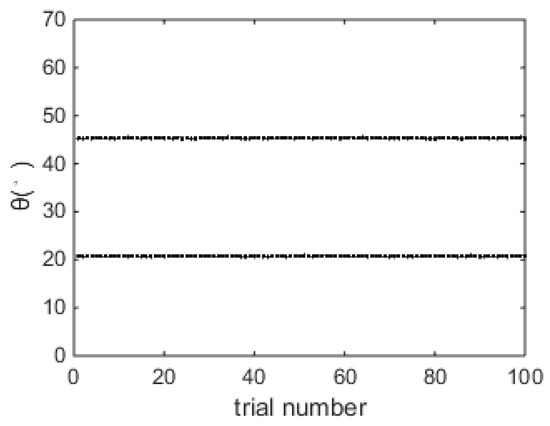
Figure 3.
DOA estimation results over 100 trials (SNR = 0dB).
The DOA estimation performance comparisons between the successive MUSIC [17], tensor-based method [25], SR-based method [26] and the proposed algorithm versus SNR and snapshot number are shown in Figure 4 and Figure 5, respectively. The grid interval used by the successive MUSIC, tensor-based method and SR-based method is 0.1°, while the grid interval of the proposed method is 1°, which can save much complexity in the sparse recovery. It is shown in Figure 4 and Figure 5 that the proposed method achieves better DOA estimation performance than the other three methods. One reason is the large DOF and aperture generated by the proposed SSN-AVS array, and the other reason is that the proposed method can amend the grid offsets caused by the off-grid sources, which lead to the performance degradations of the other three methods, despite a finer grid they used. To verify the two reasons that lead to the performance improvement, we test the proposed method under other two configurations: 1. uses traditional array geometry, 2. uses the proposed geometry but utilizes general SR instead of joint SR in Section 3.3. The DOA estimation performance comparison between these three situations has been shown in Figure 6, which indicates that the both the array geometry and joint SR contribute to the performance improvement, especially the array geometry. As explained in Section 3.3, the aperture extension is unavailable and the final achievable DOF will be greatly reduced if the traditional array geometry is used.
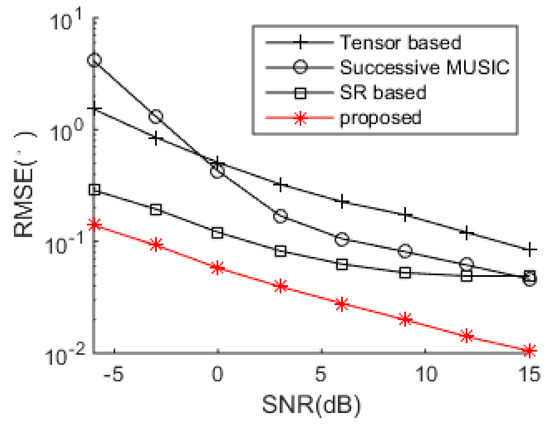
Figure 4.
DOA estimation performance comparison.
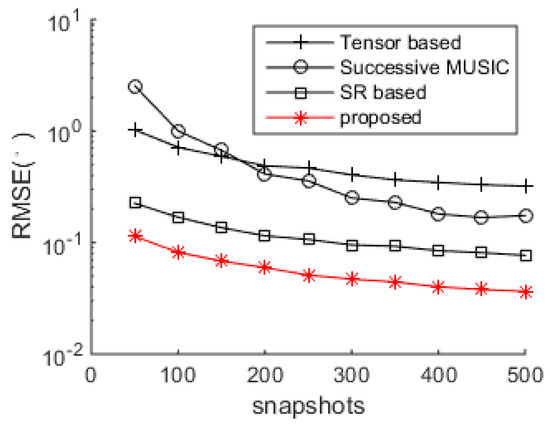
Figure 5.
DOA estimation performance comparison versus snapshots (SNR = 0dB).

Figure 6.
DOA estimation performance improvement contributor verification.
In Figure 7 and Figure 8, two closely spaced sources with DOAs respectively being and are adopted to test the resolutions of the algorithms. When SNR = 5 dB, subspace-based methods including the tensor-based method and successive MUSIC fail to identify the two closely spaced sources, while the SR-based method and the proposed method still work well due to the super-resolution property of sparse recovery technique. When SNR gets lower in Figure 8, the SR-based method fails, and the proposed method can approximately identify the two sources (with visible deviations). Consequently, the proposed method shows finer angular resolution than the other methods. To further evaluate the resolution performances of the methods, Figure 9 shows the DOA estimation performance comparison versus angular separation when SNR = 5 dB. The reference angle is set as , and the second angle is , where denotes the angular separation varying among the range . It is shown that the subspace-based methods cannot achieve effective results within the given range, and the SR-based method and the proposed method work better, especially when (can clearly identify the two sources). Meanwhile, the proposed method always achieves the best DOA estimation performance versus the variation of the angular separation.
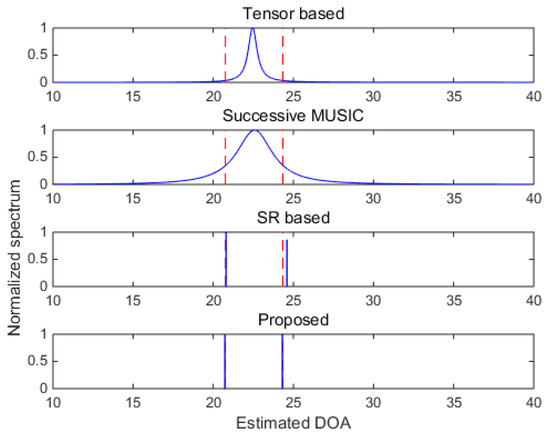
Figure 7.
DOA estimation results with closely spaced sources (SNR = 5 dB).
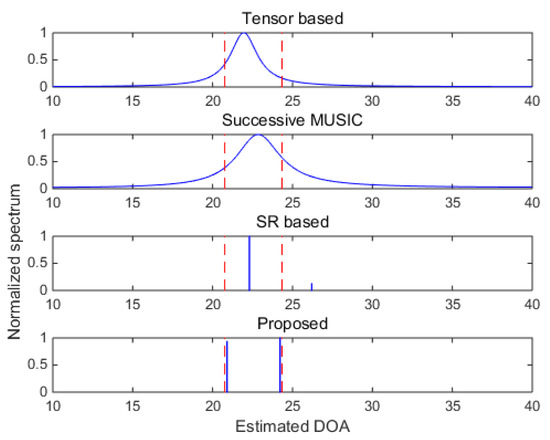
Figure 8.
DOA estimation results with closely spaced sources (SNR = −5 dB).
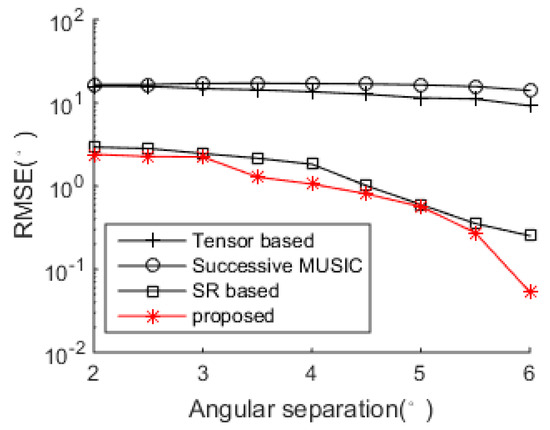
Figure 9.
DOA estimation performance comparison versus angular separation (SNR = 5 dB).
Figure 10 shows the DOA estimation performance comparison with non-uniform spatial noise. Compared to Figure 4, both the tensor-based method and successive MUSIC method have performance degradations. The subspace-based methods are sensitive to nonuniform noise due to the permeation between the signal and noise subspaces. Both the SR-based method and the proposed method is robust to nonuniform noise due to the usage of cross covariance matrix, which can effectively restrain the power of nonuniform noise.
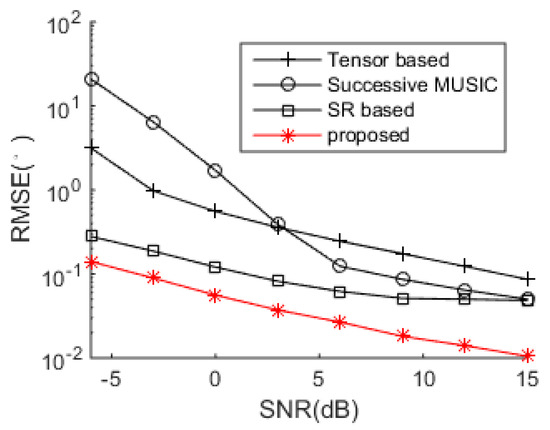
Figure 10.
DOA estimation performance comparison with non-uniform spatial noise.
5. Conclusions
In this paper, the SSN-AVS array is designed and a corresponding partial angular SR-based DOA estimation method is proposed. Multiple analyses and simulations verify that the proposed method has the following advantages:
- It requires neither EVD nor peak searching, and only requires a real-valued dictionary covering the partial angular domain with a coarse grid, thereby having low complexity.
- Based on the SSN-AVS array, it obtains large DOF and aperture, which can improve DOA estimation performance and spatial resolution.
- It is robust to off-grid sources based on the joint SR formulation.
- It is robust to non-uniform noise due to the usage of the cross-covariance matrix.
Author Contributions
J.L. raised the idea and wrote the paper; Z.L. performed the experiments and analyzed the results; X.Z. helped to discuss the results and revise the paper. All authors have read and approved the submission of the manuscript.
Funding
This work was supported by National science foundation of China (NSFC 61601167), Key Laboratory of Dynamic Cognitive System of Electromagnetic Spectrum Space (Nanjing University of Aeronautics and Astronautics), Ministry of Industry and Information Technology (KF20181915) and the Fundamental Research Funds for the Central Universities (2018B15914).
Conflicts of Interest
The authors declare no conflict of interest.
References
- Krim, H.; Viberg, M. Two decades of array signal processing research: The parametric approach. IEEE Signal Process. Mag. 1996, 13, 67–94. [Google Scholar] [CrossRef]
- Zhu, G.; Zhong, C.; Suraweera, H.A.; Karagiannidis, G.K.; Zhang, Z.; Tsiftsis, T.A. Wireless information and power transfer in relay systems with multiple antennas and interference. IEEE Trans. Commun. 2015, 63, 1400–1418. [Google Scholar] [CrossRef]
- Donelli, M.; Viani, F.; Rocca, P.; Massa, A. An Innovative multiresolution approach for DOA estimation based on a support vector classification. IEEE Trans. Antennas Propag. 2009, 57, 2279–2292. [Google Scholar] [CrossRef]
- Zhu, Q.; Li, H.; Fu, Y.; Wang, C.X.; Tan, Y.; Chen, X.; Wu, Q. A Novel 3D non-stationary wireless MIMO channel simulator and hardware emulator. IEEE Trans. Commun. 2018, 66, 3865–3878. [Google Scholar] [CrossRef]
- Wang, X.; Wang, W.; Li, X.; Liu, J. Real-valued covariance vector sparsity-inducing DOA estimation for monostatic MIMO radar. Sensors 2015, 15, 28271–28286. [Google Scholar] [CrossRef] [PubMed]
- Zhang, X.; Xu, L.; Xu, L.; Xu, D. Direction of departure (DOD) and direction of arrival (DOA) estimation in MIMO radar with reduced-dimension MUSIC. IEEE Commun. Lett. 2010, 14, 1161–1163. [Google Scholar] [CrossRef]
- Zhang, H.; Gao, Z.; Fu, H. A high resolution random linear sonar array based MUSIC method for underwater DOA estimation. In Proceedings of the 32nd Chinese Control Conference, Xi’an, China, 26–28 July 2013; pp. 4592–4595. [Google Scholar]
- Wu, Q.; Ding, G.; Wang, J.; Yao, Y. Spatial-temporal opportunity detection for spectrum-heterogeneous cognitive radio networks: Two-dimensional sensing. IEEE Trans. Wirel. Commun. 2013, 12, 516–526. [Google Scholar] [CrossRef]
- Feng, Z.; Qiu, C.; Feng, Z.; Wei, Z.; Li, W.; Zhang, P. An effective approach to 5G: Wireless network virtualization. IEEE Commun. Mag. 2015, 53, 53–59. [Google Scholar] [CrossRef]
- Nehorai, A.; Paldi, E. Acoustic vector-sensor array processing. IEEE Trans. Signal Process. 1994, 42, 2481–2491. [Google Scholar] [CrossRef]
- Wong, K.T.; Zoltowski, M.D. Extended-Aperture underwater acoustic multisource azimuth/elevation direction-finding using uniformly but sparsely spaced vector hydrophones. IEEE J. Ocean. Eng. 1997, 22, 659–672. [Google Scholar] [CrossRef]
- Hawkes, M.; Nehorai, A. Acoustic vector-sensor beamforming and Capon direction estimation. IEEE Trans. Signal Process. 1998, 46, 2291–2304. [Google Scholar] [CrossRef]
- Wong, K.T.; Zoltowski, M.D. Self-Initiating MUSIC-based direction finding in underwater acoustic particle velocity-field beamspace. IEEE J. Ocean. Eng. 2000, 25, 262–273. [Google Scholar] [CrossRef]
- He, J.; Liu, Z. Two-dimensional direction finding of acoustic sources by a vector sensor array using the propagator method. Signal Process. 2008, 88, 2492–2499. [Google Scholar] [CrossRef]
- Zhang, X.; Zhou, M.; Li, J. A PARALIND decomposition-based coherent two-dimensional direction of arrival estimation algorithm for acoustic vector-sensor arrays. Sensors 2013, 13, 5302–5316. [Google Scholar] [CrossRef] [PubMed]
- He, J.; Swamy MN, S.; Ahmad, M.O. Joint DOD and DOA estimation for MIMO array with velocity receive sensors. IEEE Signal Process. Lett. 2011, 18, 717–720. [Google Scholar] [CrossRef]
- Zhang, X.; Zhou, M.; Chen, H.; Li, J. Two-dimensional DOA estimation for acoustic vector-sensor array using a successive MUSIC. Multidimens. Syst. Signal Process. 2014, 25, 583–600. [Google Scholar] [CrossRef]
- Vaidyanathan, P.; Pal, P. Sparse sensing with co-prime samplers and arrays. IEEE Trans. Signal Process. 2011, 59, 573–586. [Google Scholar] [CrossRef]
- Pal, P.; Vaidyanathan, P. Nested arrays: A novel approach to array processing with enhanced degrees of freedom. IEEE Trans. Signal Process. 2010, 58, 4167–4181. [Google Scholar] [CrossRef]
- Zhou, C.; Shi, Z.; Gu, Y.; Shen, X. DECOM: DOA estimation with combined MUSIC for coprime array. In Proceedings of the 2013 International Conference on Wireless Communications and Signal Processing, Hangzhou, China, 24–26 October 2013; pp. 1–5. [Google Scholar]
- Sun, F.; Gao, B.; Chen, L.; Lan, P. A low-complexity ESPRIT-Based DOA estimation method for co-prime linear arrays. Sensors 2016, 16, 1367. [Google Scholar] [CrossRef]
- Qin, S.; Zhang, Y.D.; Amin, M.G. DOA estimation of mixed coherent and uncorrelated signals exploiting a nested MIMO system. In Proceedings of the 2014 IEEE Benjamin Franklin Symposium on Microwave and Antenna Sub-Systems for Radar, Telecommunications, and Biomedical Applications (BenMAS), Philadelphia, PA, USA, 27 September 2014; pp. 1–3. [Google Scholar]
- Li, J.; Jiang, D.; Wang, F. DOA estimation for sparse nested MIMO radar with velocity receive sensor array. Multidimens. Syst. Signal Process. 2018, 29, 1397–1410. [Google Scholar] [CrossRef]
- Wu, N.; Liang, Q. Underwater DoA estimation based on nested array. In Proceedings of the MILCOM 2015—2015 IEEE Military Communications Conference, Tampa, FL, USA, 26–28 October 2015; pp. 216–221. [Google Scholar]
- Han, K.; Nehorai, A. Nested vector-sensor array processing via tensor modeling. IEEE Trans. Signal Process. 2014, 62, 2542–2553. [Google Scholar] [CrossRef]
- Li, J.; Wang, F.; Zhang, X. Two dimensional angle estimation using separate nested acoustic vector sensor array. In Proceedings of the 2017 9th International Conference on Wireless Communications and Signal Processing (WCSP), Nanjing, China, 11–13 October 2017; pp. 1–6. [Google Scholar]
- Chi, Y.; Scharf, L.L.; Pezeshki, A.; Calderbank, A.R. Sensitivity to basis mismatch in compressed sensing. IEEE Trans. Signal Process. 2011, 59, 2182–2195. [Google Scholar] [CrossRef]
- Yang, Z.; Xie, L.; Zhang, C. Off-grid direction of arrival estimation using sparse Bayesian inference. IEEE Trans. Signal Process. 2011, 61, 38–43. [Google Scholar] [CrossRef]
- Chen, T.; Wu, H.; Zhao, Z. The real-valued sparse direction of arrival (DOA) estimation based on the Khatri Rao product. Sensors 2016, 16, 693. [Google Scholar] [CrossRef] [PubMed]
- Haardt, M.; Nossek, J.A. Unitary ESPRIT: How to obtain increased estimation accuracy with a reduced computational burden. IEEE Trans. Signal Process. 1995, 43, 1232–1242. [Google Scholar] [CrossRef]
- Tan, Z.; Nehorai, A. Sparse direction of arrival estimation using co-prime arrays with off-grid targets. IEEE Signal Process. Lett. 2013, 21, 26–29. [Google Scholar] [CrossRef]
- Xin, J.; Zheng, N.; Sano, A. Simple and efficient nonparametric method for estimating the number of signals without eigen decomposition. IEEE Trans. Signal Process. 2007, 55, 1405–1420. [Google Scholar] [CrossRef]
© 2018 by the authors. Licensee MDPI, Basel, Switzerland. This article is an open access article distributed under the terms and conditions of the Creative Commons Attribution (CC BY) license (http://creativecommons.org/licenses/by/4.0/).